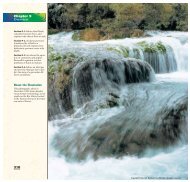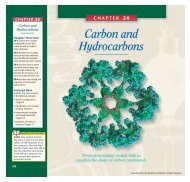Physical Characteristics of Gases
Physical Characteristics of Gases
Physical Characteristics of Gases
Create successful ePaper yourself
Turn your PDF publications into a flip-book with our unique Google optimized e-Paper software.
<strong>of</strong> air for each breath is 505 cm 3 at 20.°C and<br />
9.95 × 10 4 Pa. What is the volume <strong>of</strong> air at STP<br />
that an individual breathes in one day? Give<br />
your answer in cubic meters.<br />
Dalton’s Law <strong>of</strong> Partial Pressures<br />
39. Three <strong>of</strong> the primary components <strong>of</strong> air are<br />
carbon dioxide, nitrogen, and oxygen. In a<br />
sample containing a mixture <strong>of</strong> only these<br />
gases at exactly one atmosphere pressure, the<br />
partial pressures <strong>of</strong> carbon dioxide and nitrogen<br />
are given as PCO2 = 0.285 torr and PN2 =<br />
593.525 torr. What is the partial pressure <strong>of</strong><br />
oxygen? (Hint: See Sample Problem 10-6.)<br />
40. Determine the partial pressure <strong>of</strong> oxygen<br />
collected by water displacement if the water<br />
temperature is 20.0°C and the total pressure<br />
<strong>of</strong> the gases in the collection bottle is<br />
730.0 torr.<br />
41. A sample <strong>of</strong> gas is collected over water at a<br />
temperature <strong>of</strong> 35.0°C when the barometric<br />
pressure reading is 742.0 torr. What is the<br />
partial pressure <strong>of</strong> the dry gas?<br />
42. A sample <strong>of</strong> oxygen is collected in a 175 mL<br />
container over water at 15°C, and the barometer<br />
reads 752.0 torr. What volume would the dry<br />
gas occupy at 770.0 torr and 15°C?<br />
43. Suppose that 120. mL <strong>of</strong> argon is collected over<br />
water at 25°C and 780.0 torr. Compute the volume<br />
<strong>of</strong> the dry argon at STP.<br />
MIXED REVIEW<br />
44. A mixture <strong>of</strong> three gases, A, B, and C, is at a<br />
total pressure <strong>of</strong> 6.11 atm. The partial pressure<br />
<strong>of</strong> gas A is 1.68 atm; that <strong>of</strong> gas B is 3.89 atm.<br />
What is the partial pressure <strong>of</strong> gas C?<br />
45. A child receives a balloon filled with 2.30 L <strong>of</strong><br />
helium from a vendor at an amusement park.<br />
The temperature outside is 311 K. What will the<br />
volume <strong>of</strong> the balloon be when the child brings<br />
it home to an air-conditioned house at 295 K?<br />
Assume that the pressure stays the same.<br />
46. A sample <strong>of</strong> argon gas occupies a volume <strong>of</strong><br />
295 mL at 36°C. What volume will the gas<br />
occupy at 55°C, assuming constant pressure?<br />
Copyright © by Holt, Rinehart and Winston. All rights reserved.<br />
CHAPTER 10 REVIEW<br />
47. A sample <strong>of</strong> carbon dioxide gas occupies<br />
638 mL at 0.893 atm and 12°C. What will the<br />
pressure be at a volume <strong>of</strong> 881 mL and a<br />
temperature <strong>of</strong> 18°C?<br />
48. At 84°C, a gas in a container exerts a pressure<br />
<strong>of</strong> 0.503 atm. Assuming the size <strong>of</strong> the container<br />
has not changed, at what Celsius temperature<br />
would the pressure be 1.20 atm?<br />
49. A weather balloon at Earth’s surface has a<br />
volume <strong>of</strong> 4.00 L at 304 K and 755 mm Hg. If<br />
the balloon is released and the volume reaches<br />
4.08 L at 728 mm Hg, what is the temperature?<br />
50. A gas has a pressure <strong>of</strong> 4.62 atm when its<br />
volume is 2.33 L. What will the pressure be<br />
when the volume is changed to 1.03 L, assuming<br />
constant temperature? Express the final<br />
pressure in torr.<br />
51. At a deep-sea station 200. m below the surface<br />
<strong>of</strong> the Pacific Ocean, workers live in a highly<br />
pressurized environment. How many liters <strong>of</strong><br />
gas at STP must be compressed on the surface<br />
to fill the underwater environment with 2.00 ×<br />
107 L <strong>of</strong> gas at 20.0 atm? Assume that temperature<br />
remains constant.<br />
CRITICAL THINKING<br />
52. Applying Models<br />
a. Why do we say the graph in Figure<br />
10-10 illustrates an inverse relationship?<br />
b. Why does the data plotted in Figure<br />
10-12 show a direct relationship?<br />
53. Relating Ideas Explain how different gases<br />
in a mixture can have the same average kinetic<br />
energy value, even though the masses <strong>of</strong> their<br />
individual particles differ.<br />
54. Inferring Conclusions If all gases behaved as<br />
ideal gases under all conditions <strong>of</strong> temperature<br />
and pressure, there would be no solid or liquid<br />
forms <strong>of</strong> these substances. Explain.<br />
55. Relating Ideas Pressure is defined as force per<br />
unit area. Yet Torricelli found that the diameter<br />
<strong>of</strong> the barometer dish and the surface area <strong>of</strong><br />
contact between the mercury in the tube and<br />
in the dish did not affect the height <strong>of</strong> mercury<br />
PHYSICAL CHARACTERISTICS OF GASES 329<br />
CHAPTER 10 REVIEW<br />
39. 166.190 torr<br />
40. 712.5 torr<br />
41. 699.8 torr<br />
42. 168 mL<br />
43. 109 mL<br />
44. 0.54 atm<br />
45. 2.18 L<br />
46. 313 mL<br />
47. 0.660 atm<br />
48. 579°C<br />
49. 299 K<br />
50. 7940 torr<br />
51. 4.00 × 108 L<br />
52. a. An increase in one variable is<br />
accompanied by a corresponding<br />
decrease in the other variable.<br />
b. An increase in one variable is<br />
accompanied by a corresponding<br />
increase in the second variable.<br />
53. At the same temperature, the<br />
molecules <strong>of</strong> higher mass have<br />
a slower average velocity, and<br />
kinetic energy depends on both<br />
mass and velocity.<br />
54. If all gases behaved ideally, the<br />
individual gas particles would<br />
never exert the attractive forces<br />
on one another that are needed<br />
to form liquids or solids.<br />
55. Both the pressure exerted by the<br />
column <strong>of</strong> mercury in the tube<br />
and the pressure exerted by the<br />
atmosphere on the surface <strong>of</strong><br />
mercury in the dish can be<br />
thought <strong>of</strong> as acting on the<br />
imaginary surface <strong>of</strong> the mercury<br />
in the tube that is level with the<br />
surface <strong>of</strong> the mercury in the<br />
dish outside the tube. Because<br />
both forces are acting on the<br />
same surface, the size <strong>of</strong> the surface<br />
is not a factor in determining<br />
the eventual pressures.<br />
56. 820 mm Hg<br />
329

















